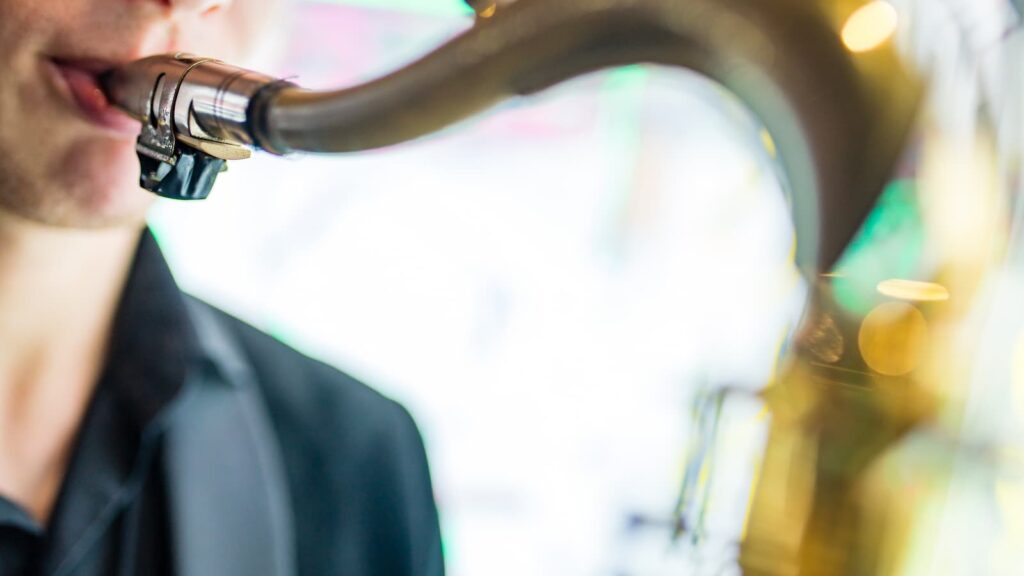If you already play the saxophone, you already have a mouthpiece. If you are getting ready to play the saxophone, you may be interested in learning more about what a mouthpiece is, how it is used, or other questions. You may also be interested in upgrading your existing mouthpiece and need guidance narrowing down your options.

What is a saxophone mouthpiece?
A saxophone mouthpiece is the part you put at the top of the saxophone on the neck, then put into your mouth to make a sound. You also hold a reed on the mouthpiece with a ligature. Without these parts, the saxophone does not make a sound.
What are saxophone mouthpieces made out of?
Saxophone mouthpieces can be made out of a variety of materials, most commonly plastic, hard rubber (ebonite), and metal.
The material affects the sound produced and also how it feels to play the saxophone. If you are considering buying a new mouthpiece and have the ability to play several first, you will get a better understanding of what may work for you. If playing them yourself is not possible, we hope our article helps give you the information you need to make a decision.
Plastic Mouthpieces for Sax
Plastic mouthpieces are usually cheaper, and beginner mouthpieces that come with some instruments are often made of plastic. They can work well for many players and reliable brands like the Yamaha 4C are consistently made.
Rubber Mouthpieces for Sax
Hard rubber mouthpieces (often called ebonite) are more durable and the material is of a higher quality than plastic. This usually makes them more expensive than plastic but the tone will be richer. Hard rubber mouthpieces like the Selmer C* and Vandoren AL3 can be used more in classical or ensemble settings. Other styles such as the Meyer 5 and the Vandoren V16 are geared more towards jazz, pop, hip hop, funk, and other more contemporary styles.
Metal Mouthpieces for Sax
Metal mouthpieces are usually more expensive and usually used for jazz and contemporary genres. The metal used makes it much easier to project at loud volumes.
Metal mouthpieces can be a good choice for jazz soloists and session musicians playing on modern popular recordings. Popular brands that make excellent metal mouthpieces include Meyer, Jody Jazz, Dukoff, Vandoren, Otto Link, Theo Wanne, and Berg Larsen.
Classical Mouthpieces for Sax
Classical mouthpieces are generally longer and more narrow. The shape gives them a more controlled sound, making them better suited for blending with other instruments such as a concert band or wind ensemble.
There is a wide range of variations affecting the way different mouthpieces feel to play and the sound they produce. Many players have different mouthpieces for different playing settings.
Jazz Mouthpieces for Sax
Jazz mouthpieces are generally shorter and have wider openings than classical mouthpieces. This helps the sound project much more and cut through other sounds in the mix, making it more easily heard.
These factors can be helpful if you play in a jazz band where the saxophones need to balance with the brass instruments and rhythm section (drum set, piano, bass, guitar, etc.) Many players use jazz mouthpieces when recording solo work on popular recordings.

FAQ: Why would I use a classical versus a jazz mouthpiece?
If you are playing in a concert band, and are looking to upgrade, you would likely be in the market for a hard rubber (ebonite) mouthpiece. The result will help you blend better in the ensemble.
Classical mouthpieces made of hard rubber are longer but more closed inside, allowing the air to flow differently than a jazz mouthpiece. This also gives you more control and allows you to play at softer dynamics.
If you are playing contemporary styles that are more soloistic or playing in a jazz band, there are hard rubber jazz mouthpieces and metal mouthpieces. Hard rubber jazz mouthpieces feel more comfortable for many, similar to classical mouthpieces, but project much more in a group setting.
Jazz mouthpieces have a brighter sound and cuts through the other sounds in the music more. Metal jazz mouthpieces do so even more and are typically very open with much more projection. The result works well if you need lots of volume, but takes a more advanced player to be able to control the sound with a good tone.
Parts of the Saxophone Mouthpiece
There are several parts of the mouthpiece and each part contributes to how the mouthpiece feels to play and the sound you can produce.
Body
If you see a reference to the body of the saxophone mouthpiece, that is the mouthpiece as a whole. Mouthpieces can be a wide range of sizes depending on the type of saxophone it is used on, or what style of music it is intended to be used for.
Chamber
The chamber is the inside of the mouthpiece towards the top. It can be more or less open depending on the style of mouthpiece. This is one of the most different aspects between mouthpieces.
Bore
The bore is the opening inside the bottom of the mouthpiece. This has a huge impact on the sound and is one of the main differences between different mouthpieces. A larger opening will need more air to fill the space but will allow you to play much louder. A more narrow opening will allow the air to travel faster through the mouthpiece, making it easier to use a harder reed and control softer dynamics easier.
Throat
The throat is the part of the mouthpiece between the chamber and the bore. This affects how the air travels through the mouthpiece and into the saxophone.
Shank
The shank is the bottom of the mouthpiece that connects to the neck. There can also be a ring around this part for extra support, but not all the time.
Table
The table is the flat surface where the reed sits. It needs to be even and flat (cheaper mouthpieces may have issues in manufacturing).
Rails
The rails are the flat surfaces along the sides and tip on the top of the mouthpiece. They should match on all sides (particularly on the left and right) which is sometimes an issue with cheaper mouthpieces. Uneven rails will make the reed respond poorly when playing.
Baffle
The baffle is the surface inside the top of the mouthpiece and the area the air hits first after going past the reed.
Tip Opening
While this is not directly a part of the mouthpiece, it is related; this refers to the opening between the reed and the top of the mouthpiece. The tip opening can be more or less depending on the style of mouthpiece.
Note: A wider tip opening creates more resistance and an edgier attack which can help a lead saxophone player cut through a jazz band more.
Saxophone Mouthe Piece Numbers (What do they mean?)
If you see a number included in the name of the saxophone mouthpiece, it typically corresponds with the size of the chamber, tip opening, and a few other related factors.
For example, Vandoren makes AL3 and AL4 mouthpieces for alto saxophone. The AL3 has a slightly smaller chamber and tip opening, making it easier for the air to travel through the mouthpiece. The AL4 projects slightly more and has a little bit more resistance when playing.
The higher the number, typically the more open the chamber and tip are. As you go up in number, saxophone players will often use lighter reeds to accommodate the difference. There are also different types of reeds better suited for classical or jazz-style mouthpieces, making it more comfortable to play with your desired sound.
What reeds work well with different saxophone mouthpieces?
The most popular saxophone reeds are Vandoren reeds. If you are new to playing, select a strength 2 or 2.5 Blue Box reed. The higher the number, the thicker the reed and the more difficult it is to play. Playing a reed under a 2 will result in a buzzy tone with less control over the sound.
Vandoren makes a wide range of reeds for saxophone. Their most popular reeds for marching band and concert band are their Blue Box reeds. Their V16 and Java reeds are used more in jazz settings.
Another option for reeds is Rico. They are cheaper but still work relatively well. Other brands that advertise significantly cheaper prices are risky as the quality will not be as good. Playing saxophone with cheap reeds can be very frustrating if they do not work well.
Do I need to upgrade my mouthpiece?
If you have been playing on your first saxophone mouthpiece for some time and feel very comfortable, but are interested in refining a more personal sound, upgrading your mouthpiece is an excellent next step. There is a huge range of options available, and each different mouthpiece is designed for different uses.
The most common route is deciding if you need a classical or jazz mouthpiece, then choosing a brand within your budget, and finally deciding on a model number. If you are able to try several mouthpieces first, this will confirm if you will achieve the sound you are after. If you are not able to try several first, we hope our recommendations help you decide on your next steps!
Disclaimer: This post may contain affiliate links. We only recommend high-quality products that are used and recommended by real musicians. If you use these links to buy something we earn a small commission.

